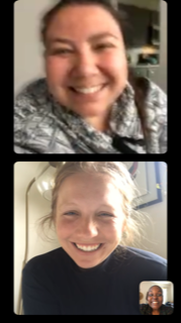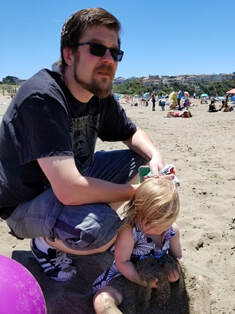

Please scroll down to read our Unconditional Education blog posts.
You can click the button below to learn more about our Unconditional Education and School Based Services!
 As with many of our partnerships and programs in Seneca, COVID-19 has thrown us all for a loop. It has been amazing to see how Seneca Staff have jumped at every opportunity to meet the needs of students, families, partnerships, and colleagues. This is especially true at our partnership with Emerson Elementary School where we have two Clinical Intervention Specialists and a Behavioral Intervention Specialist, working what seems like 24 hours a day. They don’t actually work 24 hours a day, don’t worry HR! They just work really, really hard. Throughout the year, and years prior, they have truly integrated themselves within the Emerson Community and have continued to be a constant support and presence throughout COVID-19. We all know that these are confusing times and can only imagine what it must feel like for our younger students. In an effort of prevention and education, Seneca Staff have developed a (Social Emotional Learning) SEL Curriculum to help students understand and explain the effects of the pandemic when students do return to school. This going to be a major aide in supporting the students as they transition back from an extended time outside of the four walls of our schools.  As one would imagine, and a number of us are experiencing at the moment, it is really difficult to connect with students and families during remote learning. Seneca Staff and Emerson have developed “Communication Captains” which assigns students to a specific staff member for weekly check-ins. This has enabled staff to help meet family needs (food, gift cards, etc.) and continue the facilitation/development of relationships. One of our weekly highlights is our food distribution to students and families during the pandemic. Not to worry, decked out in PPE and social distancing, staff joyously wave to students and families as they coordinate and deliver food packages throughout the Emerson Community. It is also important to acknowledge the affects that COVID-19 has had on our colleagues (including colleagues within our partnership). Seneca Staff at Emerson regularly meet with teachers and provide mental health supports for those who are experiencing their own struggles with COVID-19. Due to the relationships that the CISs and BIS have within the partnership, School Administration highly values these individuals and have trusted them in leading weekly professional development opportunities at the school which include in deep discussions at their book club (“Brain Wash”) and yoga sessions from Seneca’s very own yogi Jenna Laube. All this to say, well done Emerson Crew, we are proud of you all and the work that you do - I appreciate ya’ll!
0 Comments
I'm Ori Gutin, a Student Support Assistant (SSA) at One Purpose School in San Francisco's Bayview District. At the start of the shelter in place, I joined an awesome group of San Francisco-based All-In! staff, comprised of SSAs, clinicians, and Unconditional Education (UE) coaches, that were dedicated to providing weekly social emotional learning (SEL) content to our students stuck at home. Our hope was to touch on issues specific to what they might be experiencing because of COVID-19. We have created SEL content on mindfulness, peace corners, yoga, identifying feelings such as frustration, worry, and now... loneliness! This week's video normalizes the feelings of loneliness that our students might be experiencing at home right now, and through a reading of the fantastic children's book The Invisible String, we help remind them that even if they are not physically with their school community, they are still connected in their hearts to everyone they love! Additionally, students are provided two handouts (Invisible String Worksheet and Special Message Worksheet) they can do at home to help them stay connected to their friends and school communities from afar. Making these weekly videos has been such a wonderful experience for me. It provides me an opportunity to think creatively about how to share social emotional learning with students in an engaging way.  While I have been working on these videos to support my passion for SEL in my professional life, I have also been working on an SEL project in my personal life – self publishing my first picture book, The Butterfly Who Flew in the Rain. My book tells the story of Cody the caterpillar who was born in the midst of a terrible thunderstorm, and his ensuing journey of transformation and self-discovery, in which he learns to not only accept life’s challenges, but to embrace them. It is meant to teach kids that even if things appear impossibly difficult, or it feels as if we are completely mired in negative emotions or situations with seemingly no end in sight, we still must never give up. It is based in the philosophy of Acceptance and Commitment Therapy, which teaches that we must not sit around just waiting for happiness or better conditions to come, but rather we must learn to live with life’s challenges, accept them, continue to act in alignment with our personal values, and move forward in our lives in a meaningful way. Given the state of our world right now, and the immense challenges facing children across the globe, I believe this story of perseverance is more important now than ever before.  I’m working with an incredible illustrator to self-publish this book, and together we are trying to print 1,000 copies. We need to raise $5,638 to get our book to the printers, and right now we have raised $4,385, which is just over 77% of the way towards our goal. After we meet our self-publishing costs, all profits made from the sale of the book will go to two local COVID-19 emergency relief funds that are supporting communities in need in my home city, San Francisco, and in the illustrator’s home state, Massachusetts. We will donate 50% of the profits to MassUndocuFund, which provides funds directly to families of undocumented immigrants who have lost their jobs, and are unable to access any state or federal relief funds in Massachusetts, and 50% to Compass Family Services, which provides emergency COVID-19 Family Care Kits, which include food, pharmaceutical, and cleaning supplies to homeless families in San Francisco. If you are interested in supporting this project, go to www.orisstories.com/support and donate $20! In return, we will ship you a signed hardcover copy of the book to anywhere in the U.S., and email you corresponding SEL worksheets and discussions questions, too!
 Name: Jacqueline Rivera Position: UE Coach in Seattle, WA What led you to your current position? I have come to appreciate my own K-12 education experience as being immersed in identities and communities other than my own. I’ve always been a curious person and always enjoyed getting to know and work with all different types of people. I studied psychology with a minor in education and found that I wanted to serve a diverse community which eventually lead me to social work particularly, school social work. I’ve had the opportunity to work in schools for almost 10 years, been an in-home ABA therapist as well as an in-home crisis family therapist here in King County, WA that has reinforced my passion of work with youth and families. Being able to work as a UE Coach allows me to interact and navigate the different systems that impact our youth and families and I will be honest, being around elementary students keeps me on my toes! I love their unfiltered, passionate voices and it brings me joy to be around that type of energy. I can’t wait to be among students again. Fun Fact: My hometown is where In-n-Out began. If you ask for extra sauce, you can see my city printed on the back. What does your average day look like? My average day has been impacted by the global pandemic just like everyone else. My typical day currently consist of keeping the same schedule as I would if I were on-site at a school. I still interface with the staff via virtual meetings, continuing the work through spaces such as MTSS & Race and Equity committees and joining the counseling team in creating weekly social emotional content for learning. I am collaborating with educators at both my school sites in navigating the challenging inequities that have been magnified due to this pandemic. I miss the students that I would see in the schools and try to join virtual meetings when available and appropriate. As a working parent, I am navigating what parenting looks like with a toddler who often joins my afternoon meetings and requests to say hello to my colleagues. Why do you do this work? I see schools as a central community hub. Schools have access and potential to connect with students, family, community members, local businesses, local faith-based organizations, and service providers. This gives schools the opportunity to build their asset map of skills, resources and community-lead solutions. I do this work because of the potential that is every student and my anchor is always equity. When I work in schools, I see the school system as a symphony, each section playing its own part, each section with its own leader. Working alongside school administrators and leaders offers the opportunity to adjust, practice and impact systems of intervention across all streams so that we can fine-tune what may be at times a loud cacophony to a full-blown orchestra. Further, as a staff of color, I do this work because the school system wasn’t built or didn’t have communities of color in mind. Every day is a chance to validate the experience of every individual, to acknowledge and name that the system and unfortunately perhaps even the school staff, has yet to reflect the population that walks through the doors. Every day is a chance to push back against the systems and to follow the lead of the communities we seek to serve.  Name: Mark Bingel-McKillips Position: Therapist at Starr King Elementary/ Lead Clinician All-In SF What led you to your current position? I’ve worked for Seneca for 18 years, starting first at the CTF in San Francisco then transitioning to SF Connections with the TBS and Therapy programs. When the opportunity arose to join a school-based program, I knew it could be a great chance to make positive change in a different environment. During this last school year, my position shifted from SF Connections to an All-In supported role. Fun Fact: My first Seneca team building activity was going skydiving. What does your average day look like? This is a hard question to answer. Since the start of the shelter in place, my job has shifted from a school-based position to supporting my Starr King caseload via telehealth when possible. Additionally, I am working as the administration on-call for Seneca’s Rapid Response hotline for one day per week and serving as a wraparound clinician under the SF Connections Wraparound Program supporting a family that has recently reunified. I’m also a father of a four-month-old baby boy and very rambunctious little girl who will turn three at the end of the month. My wife, Sarah, also is working from home. Our days have become a bit of a dance - going from Zoom meetings to sending emails, changing diapers, teaching ABC’s, writing docs, having a quick dance party, holding a telehealth session, making mac n’ cheese, putting in laundry, and going to another Zoom meeting. Why do you do this work? I do this work for so many reasons, but the biggest will always be the opportunity to work with children and families to make their lives just a little be better. We are change makers. Overnight and without any warning, our students’ parents and caregivers were asked to become teachers. One thing we have found while supporting parents in this new role is that there is a LOT of information out there. Many of the parents we have talked to have felt overwhelmed by the flood of emails, text links, and other resources that have been sent their way. We have found it helpful taking things “back to basics”—talking through steps to help parents structure their child’s space and time during distance learning (MTSS fans might even think of this as helping parents set up their “Tier 1” of learning-at-home). The following is a checklist we have put together, mainly adapted from these super helpful resources: Distance Learning: 8 Tips to Help Your Child Learn at Home and Family Engagement: Supporting Students With Disabilities During COVID 1. Create a Clutter-Free Learning Space for Your ChildDoes your child have a special place to do homework? It is important to set up a quiet, clutter-free area if your child is learning full-time from home. One idea could be to convert the kitchen table into a learning station. Turn off the TV and remove all cups, salt and pepper, and other kitchen items when your child is doing schoolwork. When it is time to eat, put away the school stuff and use it again as a kitchen table. 2. Make a Schedule and Stick to itWe are creatures of habit. With no school bell to beat, kids might feel like sleeping in, and with no set schedule, it can be hard to get around to schoolwork. Here are a few questions to help you and your child come up with a schedule that works: 
3. Reduce Distractions  Our homes are full of distractions. Make a list of the things that distract your child and then find ways to limit them during learning time. For example, is the dog a big distraction? If so, consider putting your dog in a separate room when your child is doing schoolwork. Are games or social media a big distraction? Try blocking them on your child’s device during instructional time. Another way to eliminate online temptations: after downloading an assignment, turn off the Wi-Fi and/or cellular service to help your child focus on the work. 4. Try and Get Plenty of Exercise  Exercise helps us think better. When we move and groove, our problem-solving, memory, and attention improve. Physical activity is a natural way to reduce stress and prevent anxiety. Look for family-friendly activities/ workouts you can do at home or in your neighborhood. The best time to exercise might be right before tackling schoolwork, but it is also good to take exercise breaks throughout the day. 5. See Which Accessibility Features Could Help your Child  Most phones, laptops, and other mobile devices have built-in assistive technology. For example, read aloud or text-to-speech can help struggling readers, and speech-to-text can help struggling writers. On YouTube, you can adjust the settings to slow down the playback speed if your child is having trouble understanding videos. You can also change the settings to show closed captions if it helps your child to read the text while listening to videos. 6. Reach Out to Your Child’s Teacher(s)Learning at home requires family support. To support your child, set up a direct line of communication with your child’s teachers. Use email, text, phone calls, or maybe even video conferencing to connect. You may even want to set up a day and time each week to talk. You can use this time to talk about challenges your child is facing, review upcoming instruction, and understand expectations. Being proactive is essential if your child is struggling. If your child has learning challenges, here are some questions to consider: 
7. Make Time for Fun Kids are missing out on a ton of social interaction with their peers, and craving opportunities to have fun and just be kids. Making time for fun activities can help take the pressure off work and learning and ease the tensions of sharing close space for long periods of time. Playworks has a great Playbook of small-group games (mostly geared for younger kids), while older students may prefer structured activities like card or board games, or just shared independent time. We are in an unprecedented time, and I cannot tell you how tired I am of hearing the word “unprecedented”. However, it is an absolutely true description of what is happening in our world. Now more than ever (another super overused phrase), it is important that we talk about what self-care looks like, the mental health of ourselves and others, and how to stay physically safe. In our normal lives, we may do well with all of these things. In the current situation, we may have to work a little bit harder. Enter: The Science Of Well-Being, the most popular course at Yale which is being offered online for FREE. In it, they cover:
 Name: Tiana Dudley Position: Unconditional Education Coach What led you to your current position? I've worked at Seneca for about 10 years collectively with some breaks to have a few kids and then went off to a charter school for a few years. Eventually, I knew it was time to come back home! Thankfully there were people in All-in eager to welcome me back and luckily there was a UE coach position open that felt like a good fit. I'm so happy to be back! Fun Fact: I'm also a U-Jam Instructor for 24hr Fitness and now on Zoom! What does your average day look like? Well now my average day is spent at my kitchen table trying to juggle work while managing the distance learning of my 3 kids. We rotate computers so everyone can have their zoom meetings and I've added janitor, cafeteria staff, teacher, counselor, and referee to my resume lol. There is a lot of coffee and then wine involved depending on the hour. I try to start my day with yoga or get out of the house for a nice hike a few times a week. Why do you do this work? I think it’s critical that all kids feel safe, valued, supported and happy at school.  Name: Geoffrey Nunez Position: Behavioral Interventions Coach What led you to your current position? Previously I was living in the Bay Area and working as part of the All-In program in Oakland. My incredibly talented wife received a job offer to be a graphic designer in Southern California so we packed up and moved. After joining the OC All-In team and worked as a BI with their program which is a hybrid of Wrap and UE, I wanted to get back to working in schools full time. Luckily for me, Sean came down with a UE program starting in LA. I love being a part of new programs so I jumped at the chance. Fun Fact/Quote: I am a black belt in jiu jitsu and teach weekly (when things were actually open). What does your average day look like? Pre-quarantine I taught/trained jiu jitsu every morning before work. Then I would have a nice long drive to the schools in LA where I was in and out of meetings and classrooms all day. On the weekend my wife and I went surfing. Why do you do this work? I truly enjoy working alongside school staff. The people in the world of education spend so much time with the kids we work with and do so much of the shaping in their lives. I spent the first half of my time with Seneca working in community based programs (WRAP, TBS, TAY) and it felt like there was a whole part of a kid’s life I had limited access or knowledge around. Working in the school based programs has been the next step in developing my skills and has been a tremendous learning experience. As we are all aware things have changed in recent months. Our professional and personal relationships have shifted, flipped and flopped 10 times over. As adults we have to the tools to manage the uncertainty caused from COVID-19. A question I continue to ask myself is, what does this mean for kids in the long run? Leah Campbell provides the following list:
Social distancing in the short term may not have a large impact on kids, but if this type of separated interactions continues for a longer period, teens may suffer down the road. Amy Learmonth explains the following: “Our brains go through their two biggest growth spurts during infancy and adolescence. These are the two periods where our brains are the most malleable and primed for learning.” “If our teens’ experiences are stunted during this time, if they’re short-changed on opportunities to grow, learn, and develop, I believe the impact from prolonged isolation will be greater on them.” How Parents can Help Kids Continue to Socially Develop While Stuck at Home Here are a couple helpful tips Leah Campbell created to outline what parents can do to help kids develop at home:
I think it’s important to note that there are no perfect answers, but it is important to remind the parents and kids we work with to do the best they can. Resources for many of the families we work with are stretched thin, academics may not be a top priority. We can continue to provide our families with creative and unique self-regulation techniques, in order to handle situations, the best they can. There is an ancient phrase that states, “it takes a village to raise a child” During these unprecedented times no more than every WE are that village.
Read the full Healthline Article to learn more about how the pandemic impacts the long-term social development of children.  Name: Yvonne Rogers Position: UE Coach What led you to your current position? A desire to continue working with students. Fun Fact: Seneca has the most incredible people where I have made many long lasting friendships. My son's donor is a retired Senecan. He got that Seneca Love! What does your average day look like? Ha! Well, since we’re in Shelter in Place things look a lot different. We start with a morning work out, then I transition right into work. Zoom doesn't care if I haven't showered LOL. My son Marley does Zoom meetings with me and even has his own keyboard to help me write emails! Why do you do this work? I started out my career with a strong desire to be a juvenile probation officer. But after 2 years of working at Juvenile Hall, I was depleted and hopeless. I would sit in staff meetings where we would spend hours discussing how many pieces of paper kids could have and then transition to talking about my favorite topic, Nutra Loaf - a disgusting blend of "nutrients" to serve the kids that were on "lock down" due to excessive behavior. When I left, I decided to switch careers and became a Collection Agent. I lasted 2 weeks! I quit with nothing lined up. Seneca Center then found me! My Uncle was on his daily walk when saw the "Now Hiring" sign at Seneca Foothill. He walked in and had a conversation with Melba! He brought me home an application (It was paper in those days) and I applied immediately. My first Seneca position was at the Group Homes and I fell in LOVE! I do this work because those babies helped me believe in hope! |
Authors:School Program Partnerships We're Hiring!Interested in joining our School Program Partnerships' Team? Check out our open positions below!
Categories:
All
Archives
May 2024
|